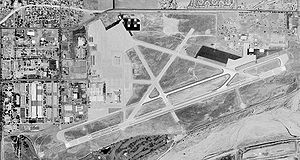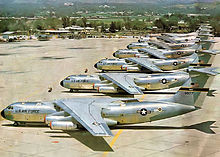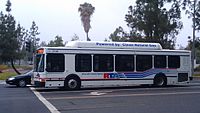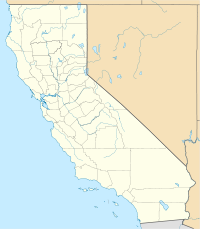- Norton Air Force Base
-
Norton Air Force Base Part of Air Mobility Command (AMC) Located in San Bernardino, California 
Norton AFB, 6 June 2002Type Air Force Base Coordinates 34°05′43″N 117°14′06″W / 34.09528°N 117.235°W Built March 1942 In use Open May 1942 - closed March 1995 Controlled by United States Air Force Garrison Air Mobility Command Occupants 63d Airlift Wing (various designations) (1967-1994) - For the civil use of this facility after March 1994, see San Bernardino International Airport
Norton Air Force Base (1942–1994) is a former front-line United States Air Force facility located 2 miles (3.2 km) east of downtown San Bernardino, California in San Bernardino County.
Contents
Overview
For the vast majority of its operational lifetime, Norton was a logistics depot and heavy-lift transport facility for a wide variety of military aircraft, equipment and supplies as part of Air Materiel/Air Force Logistics Command (1946–1966), then as part of Military Airlift/Air Mobility Command (1966–1994).
Major secondary missions of Norton Air Force Base was as Headquarters Air Defense Command for Southern California, during the 1950s and 1960s. The Air Force Audio-Visual Center produced a wide variety of Air Force films for training and public relations. The Air Force Now film, shown at all monthly Commander's Calls at Air Force Bases around the world was produced at Norton. Norton also hosted numerous Air Force Reserve transport units. The Office of the Inspector General was also located at Norton, as was the Directorate of Aerospace Safety.
Norton AFB was closed as a result of Base Realignment and Closure (BRAC) action 1988 in 1994.
History
Leland Francis Norton
Norton Air Force Base was named for San Bernardino native Capt. Leland Francis Norton (1920–1944). While attacking a marshaling yard on his 16th combat mission, Captain Norton's A-20 Havoc was struck by antiaircraft fire on 27 May 1944 near Amiens, France. After ordering his crew to bail out, Captain Norton perished with his Havoc. His portrait hung in the Officers' Club until base closing.
World War II
Norton Air Force Base began before World War II as Municipal Airport, San Bernardino under Army Air Corps jurisdiction. During the summer of 1941 it became a training base to meet the needs of the 30,000 Pilot Training Program. In December 1941, within days after the attack on Pearl Harbor, combat-ready fighter planes arrived to protect the Los Angeles area from enemy attack
On 1 March 1942, the airport was renamed San Bernardino Army Air Field and the San Bernardino Air Depot was established there. The first aircraft arrived at the new base on 2 June 1942. All runways were completed by December and night flying was initiated in March 1943. During the war, Norton's primary function was the repair and maintenance of aircraft. At the end of the war, the base became a processing and separation center for the millions of servicemen being discharged. On April 7, 1947, George G. Lundberg was named base commander.[1]
Logistics Depot
With the Air Force moving into the jet age in the late 1940s, Norton began overhauling jet engines in 1951, and the San Bernardino Air Materiel Area became one of three Air Force jet overhaul centers by 1953. To accommodate the largest Strategic Air Command bombers, the main runway was extended to 10,000 ft by 1954. B-45 Tornado upgrades were performed at Norton in the late 1940s.
On 29 November 1957, Gen. Thomas D. White disclosed the development of an anti-missile called the Wizard, the assignment of intercontinental and intermediate-range ballistic missile programs to Strategic Air Command, and a transfer of the 1st Missile Division to SAC. Also, the San Bernardino Air Force Depot, California, would assume support for long-range ballistic missile programs.[2]
In the 1960s, Norton expanded its depot support mission by supporting Titan and Atlas Intercontinental Ballistic Missiles (ICBM)s, with depot-level logistical support. Also SAMSO, the Space and Missile Systems Organization, which managed the Minuteman and Peacekeeper programs, was located at Norton from the 1960s. Upon base closure, the mission was transferred to Los Angeles Air Force Station, later, Los Angeles Air Force Base.
Strategic Airlift
 Brand new 63d MAW C-141As on the ramp at Norton AFB, 1967. Serial 66-0177 is in foreground. This aircraft will become the famous "Hanoi Taxi" which flew Bob Hope to USO shows in South Vietnam and in 1973, during the final days of the Vietnam War, repatriated American POWs from North Vietnam. Arizona Senator John McCain was one of the POWs who flew home on the Hanoi Taxi. 66-0177 was the last C-141 to be withdrawn from Air Force service after a career of almost 40 years, as the last of the fleet was retired in 2006. 66-0177 today is on permanent display at the National Museum of the United States Air Force
Brand new 63d MAW C-141As on the ramp at Norton AFB, 1967. Serial 66-0177 is in foreground. This aircraft will become the famous "Hanoi Taxi" which flew Bob Hope to USO shows in South Vietnam and in 1973, during the final days of the Vietnam War, repatriated American POWs from North Vietnam. Arizona Senator John McCain was one of the POWs who flew home on the Hanoi Taxi. 66-0177 was the last C-141 to be withdrawn from Air Force service after a career of almost 40 years, as the last of the fleet was retired in 2006. 66-0177 today is on permanent display at the National Museum of the United States Air Force
A change of mission in 1966 from Air Force Logistics Command to Military Airlift Command (MAC) meant that Norton became one of six Military Airlift Command strategic-airlift bases, supporting US Army and Marine Corps' airlift requirements among other functions. Also, a new MAC passenger terminal was built to replace the World War II era (1944) facility to better handle passenger traffic, primarily to and from Southeast Asia. The new airline-style building was activated in 1968. The base newspaper in this era was named "The Globetrotter".
Discrete C-130 Hercules modification tests were conducted out of Area II of the base in the late 1960s, with the 1198th Operational Evaluation and Training Squadron operating four highly-classified C-130E(I) special operations testbeds modified at Lockheed Air Services, at near-by Ontario Airport under projects Thin Slice/Heavy Chain.[3][4] Their electronics suites were developed for and identical to those of the MC-130 Combat Talon, with the addition of Forward looking infrared, and 1198th OE&TS test missions were flown out of Takhli Royal Thai Air Force Base, Thailand, under project "Heavy Chain", with the aircraft painted all-black.
A base railroad system interchanged with the Pacific Electric/Southern Pacific branch line on the south side of the installation. When base rail operations were discontinued in the late 1970s, the base diesel locomotive, a General Electric centercab B/B 90/90, USAF 8580, was donated to the Orange Empire Railway Museum at Perris, California.
Air Defense Command
In 1950, Air Defense Command activated the 27th Air Division (Defense) at Norton AFB, being assigned to the Western Air Defense Force. Its mission was the air defense of southern California and later southern Nevada. By 1953, its area of control included a small portion of Arizona. The 27th AD controlled both aircraft interceptor squadrons, as well as general surveillance antiaircraft radar squadrons.
In 1955, the 27th AD established a Manual Air-Defense Control Center (ADCC) (P-84) at Norton to monitor and track aircraft in Southern California. This manual site was replaced in 1959 by a Semi Automatic Ground Environment (SAGE) Data Center (DC-17) 34°06′19″N 117°13′05″W / 34.10528°N 117.21806°W. The SAGE system was an automated computer network linking Air Force (and later FAA) General Surveillance Radar stations into a centralized center for Air Defense, intended to provide early warning and response for a Soviet nuclear attack. It was initially under the Los Angeles Air Defense Sector (LAADS), established on 1 February 1959 by redesignation of 27th Air Division.
LAADS was inactivated on 1 April 1966 and the designation was returned as the 27th Air Division, being stationed at Luke AFB, Arizona under Fourth Air Force as part of a consolidation with the inactivating Phoenix Air Defense Sector. DC-17 at Norton was inactivated a few months later on 25 June 1966, its mission being consolidated with SAGE Data Center DC-21 at Luke AFB under the 27th AD.
The SAGE Direction Center closed in 1966 along with the other ADC facilities at Norton. It became the home of the Air Force Audiovisual Service, home of the Air Force Now films, as well as the Air Force historical films. The windowless, temperature controlled SAGE structure was perfect for film storage. It also was the home of the Air Combat Camera Service. After Norton closed in April 1994, the facility was essentially abandoned, and remains so to this day. Many smaller structures have been torn down in its vicinity, and likely it remains standing is due to its thick, heavily-reinforced concrete and steel construction, designed to absorb high explosive detonations.
Closure
Norton was placed on the Department of Defense's base closure list in 1989 (the same year that the DoD signed the Federal Facilities Agreement with the EPA).
The closure was cited as due to environmental wastes, inadequate facilities, and air traffic congestion (due to air traffic from Ontario International Airport, twenty miles (32 km) west, and Los Angeles International Airport, 60 miles (97 km) west) .
The last of the facilities on the base were closed in 1995.
Previous names
- Municipal Airport San Bernardino (under Army Air Forces jurisdiction), 2 July 1942
- San Bernardino Army Air Field, 14 July 1942
- San Bernardino Air Field, 24 December 1947
- San Bernardino Air Force Base, 13 January 1948
- Norton Air Force Base, 2 March 1950-1 April 1994
Major commands to which assigned
- Fourth Air Force, 2 July 1942 - 13 October 1942
- Air Service Command, 13 October 1942 - 14 July 1944
- AAF Materiel and Services Command, 14 July - 31 August 1944
- AAF Technical Services Command, 31 August 1944 - 1 July 1945
- Air Technical Services Command, 1 July 1945 - 9 March 1946
- Air Materiel Command, 9 March 1946 - 1 April 1961
- Air Force Logistics Command, 1 April 1961 - 1 July 1966
- Military Airlift Command, 1 July 1966 - 1 June 1992
- Air Mobility Command, 1 June 1992 - 1 April 1994
Major units assigned
- 11th Station Complement, 11 May 1942 - 1 February 1943
- 499th Base HQ/Air Base Squadron, 1 February 1943 - 1 April 1944
- 4126th Army Air Force Base Unit, 1 April 1944 - 26 September 1947
- 4126th Air Force Base Unit, 26 September 1947 - 31 August 1948
- 2928th Depot Maintenance Group, 31 August 1948 - 1 May 1953
- 9077th Air Reserve Group, 17 June 1949-1 November 1955
- 29th Air Depot Wing, 10 November 1949-10 November 1951
- San Bernardino Air Material Area, 1 December 1949 - 1 July 1966
- 2950th Depot Training Wing, 7 November 1951 - 19 November 1952
- 2848th Air Base Wing, 1 May 1953 - 1 April 1967
- Air Force Audio-Visual Center, 8 April 1969 - 30 March 1994
- 63d Military Airlift Wing, 1 April 1967 - 30 March 1994
- 944th Military Airlift Group, 25 March 1968 - 1 July 1993 (AFRES)
- 445th Military Airlift Wing, 1 July 1973 - 30 March 1994 (AFRES)
- 27th Air Division, 20 September 1950-1 October 1959
- Los Angeles Air Defense Sector, 15 February 1959-25 June 1966
- 1st Fighter-Interceptor Wing, 1 December 1951-6 February 1952
- 4705th Defense Wing, 1 February 1952-1 March 1952
- 659th Aircraft Control and Warning Squadron, 20 June 1953-22 June 1955
- 685th Aircraft Control and Warning Squadron, 1 January 1951-6 February 1952
- 865th Radar Squadron (SAGE), 8 November 1955-1 April 1956
Highlights
- On 24 March 1944, the second of only two Vultee XP-54 experimental fighters made its first and only flight, landing at Norton with a failed Lycoming engine. The P-54 project was canceled and the airframe grounded to support the first prototype.[5]
- Norton AFB served as the last assignment for Chuck Yeager. He retired at the base on 1 June 1975.
- Norton AFB was the final duty station of Sgt. John Levitow the lowest ranking man to be awarded the Medal of Honor, where he served as a loadmaster with the 63d Military Airlift Wing.
- The famed C-141 Starlifter Hanoi Taxi was based at Norton AFB with the 63d Military Airlift Wing at the time of its famous missions as part of Operation Homecoming.
- In 1957, while flying aboard a C-124 Globemaster II, the WAF Band was invited by General James L. Jackson, Deputy Commander of the San Bernardino Air Materiel Area, Air Materiel Command,[6] to move to his headquarters at Norton AFB. The move took place in January 1958. The band retained its training and chain-of-command connection with the USAF band school at Bolling AFB, Washington, D.C. At Norton, the band found it easier to schedule C-124 planes and pilots to keep up their touring schedule. Upon arriving, the 55 female airmen discovered that their new housing facilities were tiny cubicles for rooms and that the shared bathroom had no doors on the toilet stalls, a disappointing change from their former quarters at Lackland AFB, Texas, and at Bolling. The women worked to transform the barracks into a more homey atmosphere. The WAF Band was deactivated in 1961. Because of the warm climate and welcoming environment, some of the women airmen settled permanently in the San Bernardino area after their tour of duty.[7]
Current status
The aviation facilities of the base were converted into San Bernardino International Airport, and 3 of the 4 stationed squadrons (all 4 of which were part of the 63d and 445th Military Airlift Wings) - C-141 Starlifter, C-21, and C-12 Huron aircraft - were moved to nearby March Air Force Base, while the remaining squadron - C-141 aircraft - was moved to McChord Air Force Base, Washington. Control of the airport and surrounding facilities was turned over to a consortium consisting of several nearby cities to manage and oversee its operation. While the airport is reported to be making money, no company currently operates scheduled flights from the airport. A bid to gain traffic from DHL was lost to March Air Reserve Base and current market conditions do not lend themselves to any airlines wanting to start service to a new airport in the Greater Los Angeles Area. However, improvements in recent years to the runway and terminal facilities as well as infrastructure support such as widening of area roads have been made and the airport is still looking for a carrier willing to begin operations.[8] Charter as well as private flights do operate from SBIA and it is also used as a base for firefighting planes when needed.
Recently, private development on the former base has helped turn the basically unused land into jobs and revenue for the city of San Bernardino as several companies have opened distribution centers on the property. Mattel opened a distribution center in 2004, consolidating three other smaller ones from around Southern California into a single location.[9] Stater Brothers Markets also built a new headquarters as well as a centralized warehousing facility. The completion of the project in 2007 consolidated the headquarters and a warehouse from nearby Colton as well as several other warehouses that had been located around the Inland Empire into a single location.[10] Industrial buildings used by Pep Boys Auto and Kohl's are also located on the premises.
Norton in popular culture
- Norton AFB was the filming site of the The Twilight Zone episode "The Last Flight" in which a World War I Royal Flying Corps pilot is transported in time in a cloud to the 1960s. An authentic Nieuport 28 was provided and flown by Frank Tallman, a Hollywood stunt pilot. The episode first aired on 5 February 1960.
- Norton AFB is mentioned in the 1992 Film Sneakers. Dan Aykroyd's character Mother states "O.K., boss, this LTX-27 concealable mike is part of the same system that NASA used when they faked the Apollo moon landings. Yeah, the astronauts broadcast around the world from a soundstage at Norton Air Force Base in San Bernardino, California. So it worked for them, shouldn't give us too many problems." [11]
See also
- San Bernardino International Airport
- California World War II Army Airfields
- List of USAF Aerospace Defense Command General Surveillance Radar Stations
References
 This article incorporates public domain material from websites or documents of the Air Force Historical Research Agency.
This article incorporates public domain material from websites or documents of the Air Force Historical Research Agency.- A Handbook of Aerospace Defense Organization 1946 - 1980, by Lloyd H. Cornett and Mildred W. Johnson, Office of History, Aerospace Defense Center, Peterson Air Force Base, Colorado
- Winkler, David F. (1997), Searching the skies: the legacy of the United States Cold War defense radar program. Prepared for United States Air Force Headquarters Air Combat Command.
- Information for Norton AFB Perm, CA
- ^ Biography of Brig. General George G. Lundberg
- ^ http://www.af.mil/information/heritage/milestones.asp?dec=1950&sd=01/01/1950&ed=12/31/1959
- ^ Olausson, Lars, Lockheed Hercules Production List - 1954-2008 - 25th ed., Såtenäs, Sweden, April 2007. Self-published. No ISBN.
- ^ Mueller, Robert, Air Force Bases Volume I - Active Air Force Bases Within the United States of America on 17 September 1982; Office of Air Force History, United States Air Force, Washington, D.C., 1989, page 447. ISBN 0-912799-53-6.
- ^ http://www.militaryfactory.com/aircraft/detail.asp?aircraft_id=412
- ^ Air Force biography: Brigadier General James L. Jackson
- ^ Dixie L. Johnson. Tribute to MaryBelle Johns Nissly (GIF image)
- ^ Kelly, David (2007-09-27 accessdate=2009-08-08). "San Bernardino Airport - Transition from Norton Air Force base in progress". The Los Angeles Times. http://www.calpilots.org/html/article.php?sid=1978.
- ^ "Mattel, San Bernardino". http://california.construction.com/projects/04_bestof/mattel_san_bernardino.asp. Retrieved 2009-08-08.
- ^ . http://www.lexisnexis.com.libproxy.lib.csusb.edu/us/lnacademic/results/docview/docview.do?docLinkInd=true&risb=21_T7111954049&format=GNBFI&sort=BOOLEAN&startDocNo=1&resultsUrlKey=29_T7111954052&cisb=22_T7111954051&treeMax=true&treeWidth=0&csi=153562&docNo=2.
- ^ Sneakers (1992) - Memorable quotes
External links
- BRAC Recommendation for Closure of Norton Air Force Base
- EPA Page on Norton Air Force Base
- Old Norton Air Force Base to Become Industrial Park
- FAA Airport Diagram (PDF), effective 20 October 2011
 Air Mobility Command (AMC)
Air Mobility Command (AMC)Numbered Air Forces 
Command
Organizations15th Expeditionary Mobility Task Force · 21st Expeditionary Mobility Task Force · 618th Air and Space Operations Center (Tanker Airlift Control Center) · USAF Expeditionary Center · Special Air MissionBases Andrews · Charleston · Dover · Fairchild · Grand Forks · Little Rock · MacDill · McChord · McConnell · McGuire · Pope · Scott · TravisGroups 317th Airlift · 463rd AirliftWings Air Base87th · 628thAir MobilityAir Refueling22nd · 92nd · 319thAirliftAir Mobility OperationsContingency Response615th · 621stBases CONUSAdair · Beale · Bong (unbuilt) · Charleston · Davis-Monthan · Dobbins · Dover · Dow · Duluth · England · Ent · Ethan Allen · Fairfax · Fort Lee · Geiger · George · Glasgow · Grand Forks · Grenier · Griffiss · Gunter · Hamilton · Hancock · Homestead · Hurlburt · Imeson · K.I. Sawyer · Kincheloe · Kingsley · Kirtland · Larson · Luke · March · Malmstrom · McCoy · McChord · McClellan · McGhee Tyson · McGuire · Minneapolis-St. Paul · Minot · Mitchel · New Castle · Niagara Falls · Norton · O'Hare · Oklahoma City · Otis · Oxnard · Paine · Perrin · Peterson · Pittsburgh · Pope · Portland · Presque Isle · Richards-Gebaur · Selfridge · Seymour Johnson · Sioux City · Snelling · Stead · Stewart · Suffolk County · Tinker · Travis · Truax · Tyndall · Vandenburg · Webb · Westover · Willow Run · Wright-Patterson · Wurtsmith · Youngstown
OverseasErnest Harmon · Frobisher Bay · Goose Bay · Keflavik · Pepperrell · Thule · Topsham

Stations CONUSAlmaden · Charleston · Clear · Cross City · Benton · Empire · Mill Valley · Montauk · Mount Hebo · North Truro · Point Arena · Rye · Thomasville · Watertown
OverseasAlbrook
Air
Defense
unitsForcesAir
DivisionsSectorsAlbuquerque · Bangor · Boston · Chicago · Detroit · Duluth · Goose · Grand Forks · Great Falls · Iceland · Kansas City · Los Angeles · Minot · Montgomery · New York · Oklahoma City · Phoenix · Portland · Reno · Sault Sainte Marie · San Francisco · Seattle · Sioux City · Spokane · Stewart · Syracuse · Washington
WingsGroups1st · 4th · 10th · 14th · 15th · 23rd · 32nd · 33rd · 50th · 52nd · 53rd · 54th · 56th · 57th · 73rd · 78th · 79th · 81st · 82nd · 84th · 325th · 326th · 327th · 328th · 329th · 337th · 355th · 408th · 412th · 414th · 473rd · 475th · 476th · 478th · 500th · 501st · 502d · 503d · 507th · 514th · 515th · 516th · 517th · 518th · 519th · 520th · 521st · 525th · 527th · 528th · 529th · 530th · 533d · 534th · 564th · 566th · 567th · 568th · 575th · 678th · 701st · 4676th · 4700th · 4721st · 4722d · 4727th · 4728th · 4729th · 4730th · 4731st · 4732d · 4733d · 4734th · 4735th · 4756th
SquadronsAerospace Defense Command Fighter Squadrons · Aircraft Control and Warning Squadrons
Major
weapon
systemsElectronicFightersMissiles1 · 2 · 3 · 4 · 5
ShipsGuardian · Interceptor · Interdictor · Interpreter · Investigator · Locator · Lookout · Outpost · Pickett · Protector · Scanner · Searcher · Skywatcher · Tracer · Watchman · Vigil
Miscellaneous Air Defense Command Emblem Gallery (On Wikimedia Commons) · General Surveillance Radar StationsMass transit in the Inland Empire region Commuter rail Metrolink • Redlands Passenger Rail (Planned)
Amtrak rail routes San Bernardino County bus service Riverside County bus service Corona Cruiser • RTA • SunLine • Palo Verde Valley Transit Agency • Pass TransitCommercial airports Categories:- 1942 establishments
- Closed facilities of the United States Air Force
- SAGE sites
- Military in San Bernardino County, California
- San Bernardino, California
- Airfields of the United States Army Air Forces in California
- September 1947 United States Air Force Installations
- Airfields of the United States Army Air Forces Technical Service Command
- Military Superfund sites
- Military facilities in California
- Aerospace Defense Command
Wikimedia Foundation. 2010.



